Balkinization
an unanticipated consequence of
Jack M. Balkin
Balkinization Symposiums: A Continuing List
E-mail:
Jack Balkin:
jackbalkin at yahoo.com
Bruce Ackerman
bruce.ackerman at yale.edu
Ian Ayres
ian.ayres at yale.edu
Corey Brettschneider
corey_brettschneider at brown.edu
Mary Dudziak
mary.l.dudziak at emory.edu
Joey Fishkin
joey.fishkin at gmail.com
Heather Gerken heather.gerken at yale.edu
Abbe Gluck abbe.gluck at yale.edu
Mark Graber
mgraber at law.umaryland.edu
Stephen Griffin
sgriffin at tulane.edu
Jonathan Hafetz
jonathan.hafetz at shu.edu
Jeremy Kessler
jkessler at law.columbia.edu
Andrew Koppelman
akoppelman at law.northwestern.edu
Marty Lederman
msl46 at law.georgetown.edu
Sanford Levinson
slevinson at law.utexas.edu
David Luban
david.luban at gmail.com
Gerard Magliocca
gmaglioc at iupui.edu
Jason Mazzone
mazzonej at illinois.edu
Linda McClain
lmcclain at bu.edu
John Mikhail
mikhail at law.georgetown.edu
Frank Pasquale
pasquale.frank at gmail.com
Nate Persily
npersily at gmail.com
Michael Stokes Paulsen
michaelstokespaulsen at gmail.com
Deborah Pearlstein
dpearlst at yu.edu
Rick Pildes
rick.pildes at nyu.edu
David Pozen
dpozen at law.columbia.edu
Richard Primus
raprimus at umich.edu
K. Sabeel Rahmansabeel.rahman at brooklaw.edu
Alice Ristroph
alice.ristroph at shu.edu
Neil Siegel
siegel at law.duke.edu
David Super
david.super at law.georgetown.edu
Brian Tamanaha
btamanaha at wulaw.wustl.edu
Nelson Tebbe
nelson.tebbe at brooklaw.edu
Mark Tushnet
mtushnet at law.harvard.edu
Adam Winkler
winkler at ucla.edu
Compendium of posts on Hobby Lobby and related cases
The Anti-Torture Memos: Balkinization Posts on Torture, Interrogation, Detention, War Powers, and OLC
The Anti-Torture Memos (arranged by topic)
Recent Posts
When Do Differences in Degree Becomes Differences in Kind? A Response to the Balkinization Symposiasts
Just A Few Blogs
ACS Blog
Alas, a Blog
Althouse
Arts and Letters Daily
Atrios (Eschaton)
Bill of Health
Buzzflash.com
Buzz Machine
Cato at Liberty
Juan Cole (Informed Comment)
Concurring Opinions
The Constitution in 2020
Corrente
Crooked Timber
Daily Howler
Daily Kos
Dana Boyd
Brad DeLong
Digby (Hullabaloo)
Discriminations
Daniel Drezner
Kevin Drum (Mother Jones)
Electrolite
En Banc
Eunomia (Daniel Larison)
Fafblog
Michael Froomkin (Discourse.net)
GovLab (Beth Noveck)
Rick Hasen (Election Law)
History News Network
How Appealing
Ignatz (Sam Heldman)
The Importance of (Ernie Miller)
Infolaw
Instapundit
International Economic Law and Policy Blog
IntLawGrrls
Jacob Levy
Jesus' General
Jurisdynamics
The Kitchen Cabinet
Mark Kleiman
Law Blog Central
Larry Lessig
Lawyers, Guns and Money
Liberal Oasis
Brian Leiter's Law School Reports
The Leiter Reports
Marginal Revolution
Megan McArdle
Memeorandum
Metafilter
Mirror of Justice
The New Republic
Newseum
No More Mister Nice Blog
Brendan Nyhan
Opinio Juris
Orcinus
The Originalism Blog
Pandagon
Passport (Foreign Policy)
Overcoming Bias
Political Animal (Washington Monthly)
Political Theory Daily Review
Political Wire (Taegan Goddard)
The Poor Man
Virginia Postrel
Prawfsblawg
Public Reason
Jonathan Rauch
Raw Story
Redstate
ReligiousLeftLaw.com
Reporters Committee For Freedom of the Press
Reproductive Rights Blog
Rothman's Roadmap to the Right of Publicity
SCOTUS Blog
Seeing the Forest
Clay Shirky
The Shifted Librarian
The Situationist
Larry Solum (Legal Theory)
Andrew Sullivan
Talking Points Memo
Talk Left
Tapped
Tbogg
TechPresident
The Paper Chase (Jurist)
Tom Paine
Tom Tomorrow (This Modern World)
Eve Tushnet
Uggabugga
University of Chicago Law School Faculty Blog
Unqualified Offerings
The Volokh Conspiracy
War and Piece (Laura Rozen)
Wampum
Oliver Willis
Wonkette
Written Description
Matthew Yglesias
Yin
Your Choice of Feeds
1. XML
powered by
2. Atom Feed
3. RSS 2.0
When Do Differences in Degree Becomes Differences in Kind? A Response to the Balkinization Symposiasts
Guest Blogger
For the Balkinization Symposium on Rogers M. Smith and Desmond King, America’s New Racial Battle Lines: Protect versus Repair (University of Chicago Press, 2024). Rogers M. Smith and Desmond King We are grateful to all the contributors to the
Balkinization Blog symposium for their serious and generous engagement with our
book, America’s New Racial Battle Lines: Protect versus Repair, and to
Jack Balkin and Mark Graber for their work in making it happen. We are also
glad of this opportunity to address the points the participants raise, which
can be organized under three questions. First, aren’t the groupings which we
call “racial policy alliances” and “racial institutional orders” concerned with
more than just racial policies? Alexandra Filindra, Evan Bernick, and James
Fleming and Linda McClain especially raise this question in diverse ways. Second, are these policy alliances really
novel or new? Rebecca Zietlow and Bernick suggest this question through their
stress on historical predecessors, Fleming and McClain close with it, and Corey
Robin presses it most strongly, with several useful specifications. Third, are there issues on which we
could and perhaps should have said more? Carol Nackenoff and Chloe Thurston provide
valuable examples in this respect, and Zietlow and Bernick’s comments are
pertinent here as well. 1. Racial Policy Institutional Orders. The first question can be resolved, we
believe, by clarifying just what racial policy alliances/institutional orders are
and are not. They are coalitions of private and public actors and organizations
that are parts of--and in some respects are both drivers of and are driven by--larger
conservative and progressive political and legal movements, as well as the two
major political parties in modern America. They are, however, not identical to or synonymous with
those broader movements or political parties, and those broader movements and
political parties are not the core subjects of our book. These coalitions bring together in
support of racial policies activists, organizations, and ultimately voters who
often have other primary political concerns, but who see considerable common
ground between racial policies and those concerns--so they join one or the
other coalition. Consequently, in describing the members of the coalitions, we
inevitably discuss the primary policy concerns that they see as connected—matters
such as immigration, mass incarceration, housing, employment, health care, education,
religious freedoms, gender, and sexuality and more. We include those policies as
shaped in part by the clashes of the Protect and Repair racial policy
alliances. So, our discussions do range beyond issues that are exclusively or
even primarily racial. Even so, we are still engaged in
describing the racial policy coalitions that are our focus, not the broader
conservative and progressive movements, not the current Republican and
Democratic Parties, and not trends in public opinion. Racial policy coalitions or alliances
are, by definition, bound together by the agreement of their otherwise often
diverse members on some basic racial policy stances. This means today either the protection or bolstering of
features in that status quo that privilege many white Americans in important ways;
or the efforts to transform the highly inegalitarian
institutionalized legacies of America’s white settler colonial origins, efforts
many describe as a quest to “repair” America. So, when Alexandra Filindra says we are
really discussing rival visions of citizenship, when Jim Fleming and Linda
McClain suggest that we are discussing “America’s battle lines more generally,”
we cannot say that they are simply wrong. We are indeed discussing those things,
but only as they relate to contemporary racial policy coalitions and policies.
We hope that our work can aid scholarly efforts to build illuminating accounts
of broader battles (Rogers Smith, for one, can certainly be counted on to draw
on it when exploring today’s conflicting civic ideals!). Our theoretical
framework of institutional orders offers one guide to how scholars might connect
our account with these related studies, and we are pleased that these
commentators do not seem to find it objectionable. How much can be achieved by
deploying it further obviously remains to be seen. 2. What’s new? Second, as Corey Robin notes, political
developments always involve both continuities and changes, making it
legitimately debatable whether truly important shifts have occurred. Robin,
whose own work stresses what
has been constant in conservative thought since the French Revolution, is a
valuable skeptic of claims to meaningful changes in conservatism, and again, he
is far from alone in perceiving at least as much continuity as transformation
in the contemporary racial policy orders. Didn’t proponents of color-blind
policies always complain about white victimization by race-conscious measures,
against which they promised protection, with real political success? Didn’t
they get support from openly white supremacist groups? Didn’t they support many
policies we label as “Protect” measures, and didn’t many Republicans oppose
some of the most extreme Trump protect policies, like retaining the names of
Confederate leaders for military bases? While accepting that there has been a
shift from color-blind v. race-conscious to protect v. repair, Fleming and
McClain query how “fundamental” this
change is. Zietlow fairly emphasizes that we’ve seen backlash before in U.S. history,
and continually since the civil rights successes of the 1960s. Bernick similarly
stresses that battles over the “reactionary constitutionalism” favored by the
contemporary Protect policy alliance are longstanding. All reasonable points, and ones with
which we wrestled. We decided that emphasizing the
continuities produces serious risks of underestimating both the political
appeal and the policy dangers of today’s Protect racial policy alliance. It
also obscures the new and severe challenges facing racial progressives today. As we detail in the book, in our
interviews both Protect and Repair advocates and organizations strongly
affirmed to us their perceptions that fundamental changes have occurred. Many
Protect proponents are bitterly angry at the moderate color-blind stances of
the Reagan and Bush administrations, who accepted “expand the pool” diversity
initiatives while opposing quotas. Today’s conservatives accuse them of failing
to end affirmative action, of not preventing the rise of Diversity, Equity, and
Inclusion (DEI) offices and programs in the public and private sectors or the
inclusion of perspectives reflecting Critical Race Theory in public schools and
museums. They are also condemned for their openness to primarily non-white
immigrants and their choices not to give new protections to racially
conservative religious traditionalists, primarily white Christian evangelicals.
Many Repair adherents similarly view the older race-conscious agenda centered
on affirmative actions to integrate people of color into existing American
institutions as profoundly inadequate. Both sides see their 21st
century opponents as far more dangerous than their foes in the late 20th century. We do not think they are wrong to do so.
Trump’s appointees to the Supreme Court
have eviscerated affirmative action in higher education and extended new
special privileges to right-wing religious groups. He and his supporters are promising
mass deportations, further privileging of conservative Christian evangelicals,
censorious controls on public education at all levels, more intensive crippling
of enforcement of traditional civil rights laws, bans on DEI that are meant to
end “expand the pool” policies in both businesses and public institutions,
renewed celebrations of Confederates and other racist leaders in American
history, and much more. These shifts are politically
consequential. Though it is true that some in the
Reagan and Bush coalitions would have supported them, their candidates did not foreground
those positions—and probably would not have been elected if they had. In
contrast, Republican Donald Trump shouted them loudly and often, and it is not
likely that he would have won in 2016 or 2024 if he had not promoted them so
ardently. Many of his 2016 primary opponents deployed the same rhetoric for the
same policies that Reagan and subsequent Republican candidates had adopted. By
stressing his differences from them, Trump demolished them, before winning a
narrow electoral college victory. Things had changed. These policy shifts also
have had and are having tremendous impacts on the lives of hundreds of millions
of people. Robin questions how fully Trump and the Protect coalition’s
preferred policies are “ordering” American life, but we believe that America
would be a significantly different and a significantly better country if they
had never come to power. We fully recognize that the Protect
coalition does have internal diversity, and it is not completely identical to
the Republican Party (though it now almost is). So, it is true that not all of
Trump’s policy proposals (which we count as Trump policies) were or will be
enacted. We also think that policies representing “multicultural conservatism”
are likely to proliferate more than all-out white supremacist ones in the years
ahead. But multicultural conservatism is not color-blindness. As its advocates explain,
it permits some limited recognition of and distinct forms of aid to racial,
ethnic, and religious communities, such as greater long-term funding for HBCUs
and more expansive religious exemptions, so long as those communities support
conservative social and economic policies and celebratory, not critical,
perspectives on the United States. Those qualifications mean, however, that
even multicultural conservatism operates to protect and preserve many of the
advantages most whites have had under existing institutional arrangements. We,
with Repair advocates, believe they therefore perpetuate many injustices. But precisely because the Repair racial
policy alliance genuinely does seek major changes in existing American
institutions, seen as extending many of the unjust arrangements rooted in the
nation’s founding as a white settler nation built in part on enslaved labor and
the forcible displacement of the continent’s Indigenous peoples, it has
struggled to make itself broadly politically appealing and to come up with
feasible alternative institutions and policies. Using race-conscious means to
integrate American institutions was never wildly popular, but it was far more
acceptable to many Americans than presentations of their country as
systematically racist and, especially, more palatable than calls for
reparations. Some might therefore say that the Repair policy alliance, at
least, will not prove enduring. Yet the Repair critique of the
inadequacy of the older race-conscious policy agenda is powerful and compelling;
and inherited inequalities have regrettably become replicated
cross-generationally Progressives may arrive at new formulations and policy
proposals, and they are likely to back away from the most radical Repair
positions, but they are unlikely to abandon the coalition’s basic themes and
goals. Since the 2024 election, California has passed into law six of the
recommendations of the state’s pioneering Reparations Task Force aimed at
curbing discrimination and providing aid to Black homeowners and businesses,
even as the Task Force’s recommendations for massive reparations payments have
gone nowhere. It is likely that racial justice groups and agencies throughout
the country will similarly pursue moderate Repair agendas for some years to
come, combined with more inclusive economic appeals. It is not clear, after
all, what else they might do. 3.
Where and How to Look Wider and Deeper? That uncertainty raises the third
question, concerning topics on which we could and perhaps should have said
more, and which in any case merit further study now and in the years ahead. While
we hope that the spread of widespread violence, our sixth scenario for the
future, is improbable, we entirely agree with Carol Nackenoff that the danger
of such heightened violence is closely tied to the degree of prominence that
white supremacists prove to have during the second Trump administration. White
extremism and violence therefore need continuing attention. Though we tried, as
Chloe Thurston urges, both to put the rival racial policy alliances into
appropriate international contexts, and to address intra-coalition divisions
and rifts, we agree that much more can and should be explored on these topics. We
also agree that the impacts of these alliances on processes of political
socialization and public opinion deserve study (by scholars more equipped than
we are for those inquiries!). As our earlier writings show, we are in
much accord with the histories of earlier racial politics sketched by Bernick
and Zietlow, and we certainly see further inquiries into how today’s politics
relate to earlier episodes of backlash and constitutional conflicts as valuable
and worthwhile. We think Bernick somewhat misapprehends us when we agree with
some conservatives that America’s revolutionary origins have been seeds of
transformative egalitarian movements, and when we say that the January 6th
insurrectionists engaged in lawless violence. The conservatives in question
bemoan those transformative movements, while we applaud them, and we know that
many invading the Capitol claimed to be upholding the Constitution, but we
reject that claim. Bernick is absolutely right, however, that the issue of
whether Aziz Rana is correct when he argues that truly transformative egalitarian
changes cannot occur within the current Constitution’s bounds is a central one
for the years ahead – both in scholarship and politically. Similarly, Corey Robin is right to raise
the question of whether truly fundamental transformations can occur if they do
not involve major changes to the nation’s capitalist economic systems. As he
and several other commentators note, we found much more evidence of rhetorical
challenges than substantive ones in the positions of the current Repair racial
policy alliance. Many Repair advocates would reply that their proposals for new
initiatives in the areas of housing, employment, health care, education,
environmental protection, and more, in some cases including direct reparation
payments, would together amount to major changes in American capitalism. Although
that claim is plausible, their coalition’s dependence on capitalist supporters
does call into doubt how aggressively these changes will be pursued. In any
case, few Repair advocates are currently emphasizing the (varied) sorts of proposals
to achieve democratic control of the economy that were central to older Left
agendas. We are not as convinced as Rana that egalitarian reforms are
incorrigibly limited under the current American Constitution, nor are we as
attracted as Robin is to the view that only
economic changes should count as fundamental, though we recognize of course
their massive significance.
But we agree that these are issues that
deserve much further thought and study, especially if those sympathetic to the
aspirations of the Repair policy alliance and its egalitarian predecessors are
to have realistic hopes of defeating the forces protecting American systems of
inequality, who are once again ascendant in American politics. We hope that our
book, and this symposium, will contribute in some small measure to those
much-needed endeavors. Rogers M. Smith is Christopher H. Browne Distinguished Emeritus Professor of Political Science at the University of Pennsylania. You can reach him by e-mail at rogerss@sas.upenn.edu. Desmond King is the Andrew W. Mellon Professor of American Government at the University of Oxford and a Fellow of Nuffield College. You can reach him by email at desmond.king at nuffield.ox.ac.uk.
Posted
3:00 PM
by Guest Blogger [link]
Books by Balkinization Bloggers

Gerard N. Magliocca, The Actual Art of Governing: Justice Robert H. Jackson's Concurring Opinion in the Steel Seizure Case (Oxford University Press, 2025)

Linda C. McClain and Aziza Ahmed, The Routledge Companion to Gender and COVID-19 (Routledge, 2024)

David Pozen, The Constitution of the War on Drugs (Oxford University Press, 2024)

Jack M. Balkin, Memory and Authority: The Uses of History in Constitutional Interpretation (Yale University Press, 2024)
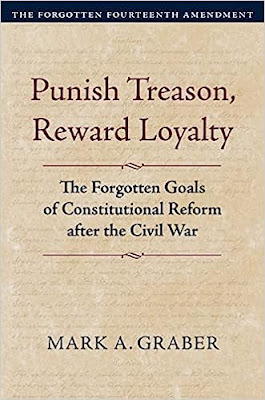
Mark A. Graber, Punish Treason, Reward Loyalty: The Forgotten Goals of Constitutional Reform after the Civil War (University of Kansas Press, 2023)
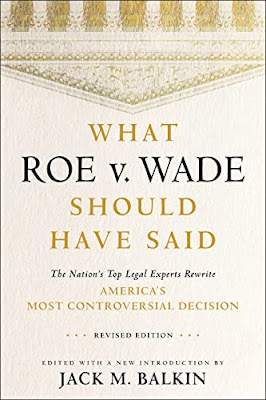
Jack M. Balkin, What Roe v. Wade Should Have Said: The Nation's Top Legal Experts Rewrite America's Most Controversial Decision - Revised Edition (NYU Press, 2023)

Andrew Koppelman, Burning Down the House: How Libertarian Philosophy Was Corrupted by Delusion and Greed (St. Martin’s Press, 2022)

Gerard N. Magliocca, Washington's Heir: The Life of Justice Bushrod Washington (Oxford University Press, 2022)
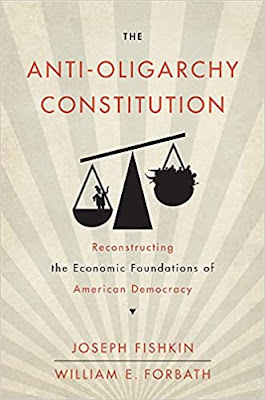
Joseph Fishkin and William E. Forbath, The Anti-Oligarchy Constitution: Reconstructing the Economic Foundations of American Democracy (Harvard University Press, 2022)

Mark Tushnet and Bojan Bugaric, Power to the People: Constitutionalism in the Age of Populism (Oxford University Press 2021).

Mark Philip Bradley and Mary L. Dudziak, eds., Making the Forever War: Marilyn B. Young on the Culture and Politics of American Militarism Culture and Politics in the Cold War and Beyond (University of Massachusetts Press, 2021).

Jack M. Balkin, What Obergefell v. Hodges Should Have Said: The Nation's Top Legal Experts Rewrite America's Same-Sex Marriage Decision (Yale University Press, 2020)

Frank Pasquale, New Laws of Robotics: Defending Human Expertise in the Age of AI (Belknap Press, 2020)

Jack M. Balkin, The Cycles of Constitutional Time (Oxford University Press, 2020)

Mark Tushnet, Taking Back the Constitution: Activist Judges and the Next Age of American Law (Yale University Press 2020).

Andrew Koppelman, Gay Rights vs. Religious Liberty?: The Unnecessary Conflict (Oxford University Press, 2020)

Ezekiel J Emanuel and Abbe R. Gluck, The Trillion Dollar Revolution: How the Affordable Care Act Transformed Politics, Law, and Health Care in America (PublicAffairs, 2020)

Linda C. McClain, Who's the Bigot?: Learning from Conflicts over Marriage and Civil Rights Law (Oxford University Press, 2020)
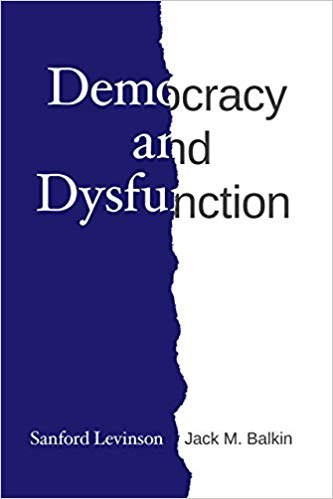
Sanford Levinson and Jack M. Balkin, Democracy and Dysfunction (University of Chicago Press, 2019)

Sanford Levinson, Written in Stone: Public Monuments in Changing Societies (Duke University Press 2018)

Mark A. Graber, Sanford Levinson, and Mark Tushnet, eds., Constitutional Democracy in Crisis? (Oxford University Press 2018)

Gerard Magliocca, The Heart of the Constitution: How the Bill of Rights became the Bill of Rights (Oxford University Press, 2018)

Cynthia Levinson and Sanford Levinson, Fault Lines in the Constitution: The Framers, Their Fights, and the Flaws that Affect Us Today (Peachtree Publishers, 2017)

Brian Z. Tamanaha, A Realistic Theory of Law (Cambridge University Press 2017)

Sanford Levinson, Nullification and Secession in Modern Constitutional Thought (University Press of Kansas 2016)

Sanford Levinson, An Argument Open to All: Reading The Federalist in the 21st Century (Yale University Press 2015)

Stephen M. Griffin, Broken Trust: Dysfunctional Government and Constitutional Reform (University Press of Kansas, 2015)

Frank Pasquale, The Black Box Society: The Secret Algorithms That Control Money and Information (Harvard University Press, 2015)

Bruce Ackerman, We the People, Volume 3: The Civil Rights Revolution (Harvard University Press, 2014)
Balkinization Symposium on We the People, Volume 3: The Civil Rights Revolution

Joseph Fishkin, Bottlenecks: A New Theory of Equal Opportunity (Oxford University Press, 2014)

Mark A. Graber, A New Introduction to American Constitutionalism (Oxford University Press, 2013)

John Mikhail, Elements of Moral Cognition: Rawls' Linguistic Analogy and the Cognitive Science of Moral and Legal Judgment (Cambridge University Press, 2013)

Gerard N. Magliocca, American Founding Son: John Bingham and the Invention of the Fourteenth Amendment (New York University Press, 2013)

Stephen M. Griffin, Long Wars and the Constitution (Harvard University Press, 2013)

Andrew Koppelman, The Tough Luck Constitution and the Assault on Health Care Reform (Oxford University Press, 2013)

James E. Fleming and Linda C. McClain, Ordered Liberty: Rights, Responsibilities, and Virtues (Harvard University Press, 2013)
Balkinization Symposium on Ordered Liberty: Rights, Responsibilities, and Virtues

Andrew Koppelman, Defending American Religious Neutrality (Harvard University Press, 2013)

Brian Z. Tamanaha, Failing Law Schools (University of Chicago Press, 2012)

Sanford Levinson, Framed: America's 51 Constitutions and the Crisis of Governance (Oxford University Press, 2012)

Linda C. McClain and Joanna L. Grossman, Gender Equality: Dimensions of Women's Equal Citizenship (Cambridge University Press, 2012)

Mary Dudziak, War Time: An Idea, Its History, Its Consequences (Oxford University Press, 2012)

Jack M. Balkin, Living Originalism (Harvard University Press, 2011)

Jason Mazzone, Copyfraud and Other Abuses of Intellectual Property Law (Stanford University Press, 2011)

Richard W. Garnett and Andrew Koppelman, First Amendment Stories, (Foundation Press 2011)

Jack M. Balkin, Constitutional Redemption: Political Faith in an Unjust World (Harvard University Press, 2011)

Gerard Magliocca, The Tragedy of William Jennings Bryan: Constitutional Law and the Politics of Backlash (Yale University Press, 2011)

Bernard Harcourt, The Illusion of Free Markets: Punishment and the Myth of Natural Order (Harvard University Press, 2010)

Bruce Ackerman, The Decline and Fall of the American Republic (Harvard University Press, 2010)
Balkinization Symposium on The Decline and Fall of the American Republic

Ian Ayres. Carrots and Sticks: Unlock the Power of Incentives to Get Things Done (Bantam Books, 2010)

Mark Tushnet, Why the Constitution Matters (Yale University Press 2010)
Ian Ayres and Barry Nalebuff: Lifecycle Investing: A New, Safe, and Audacious Way to Improve the Performance of Your Retirement Portfolio (Basic Books, 2010)
.jpg)
Jack M. Balkin, The Laws of Change: I Ching and the Philosophy of Life (2d Edition, Sybil Creek Press 2009)

Brian Z. Tamanaha, Beyond the Formalist-Realist Divide: The Role of Politics in Judging (Princeton University Press 2009)
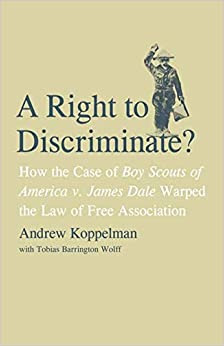
Andrew Koppelman and Tobias Barrington Wolff, A Right to Discriminate?: How the Case of Boy Scouts of America v. James Dale Warped the Law of Free Association (Yale University Press 2009)

Jack M. Balkin and Reva B. Siegel, The Constitution in 2020 (Oxford University Press 2009)
Heather K. Gerken, The Democracy Index: Why Our Election System Is Failing and How to Fix It (Princeton University Press 2009)

Mary Dudziak, Exporting American Dreams: Thurgood Marshall's African Journey (Oxford University Press 2008)

David Luban, Legal Ethics and Human Dignity (Cambridge Univ. Press 2007)

Ian Ayres, Super Crunchers: Why Thinking-By-Numbers is the New Way to be Smart (Bantam 2007)

Jack M. Balkin, James Grimmelmann, Eddan Katz, Nimrod Kozlovski, Shlomit Wagman and Tal Zarsky, eds., Cybercrime: Digital Cops in a Networked Environment (N.Y.U. Press 2007)

Jack M. Balkin and Beth Simone Noveck, The State of Play: Law, Games, and Virtual Worlds (N.Y.U. Press 2006)

Andrew Koppelman, Same Sex, Different States: When Same-Sex Marriages Cross State Lines (Yale University Press 2006)
Brian Tamanaha, Law as a Means to an End (Cambridge University Press 2006)
Sanford Levinson, Our Undemocratic Constitution (Oxford University Press 2006)
Mark Graber, Dred Scott and the Problem of Constitutional Evil (Cambridge University Press 2006)
Jack M. Balkin, ed., What Roe v. Wade Should Have Said (N.Y.U. Press 2005)
Sanford Levinson, ed., Torture: A Collection (Oxford University Press 2004)
Balkin.com homepage
Bibliography
Conlaw.net
Cultural Software
Writings
Opeds
The Information Society Project
BrownvBoard.com
Useful Links
Syllabi and Exams